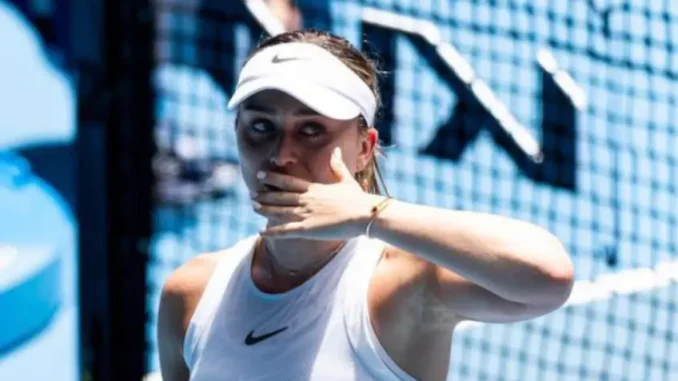
In the high-stakes world of professional tennis, where every swing of the racket can define a career, Paula Badosa has carved out a name for herself with grit, talent, and an unyielding spirit. The Spanish star, once heralded as the heir to Maria Sharapova’s throne, recently opened up about a lingering regret tied to those early comparisons—a confession that peels back the layers of pressure and expectation that have shadowed her journey. Now ranked among the WTA’s elite, Badosa’s story is one of triumph over adversity, but also a candid reflection on how the weight of being dubbed “the next Sharapova” nearly broke her.
From her teenage years, Badosa was a standout, clinching the 2015 French Open junior title and igniting hopes that she’d follow in the footsteps of the Russian legend, a five-time Grand Slam champion known for her fierce competitiveness and glamorous persona. The parallels were striking: both tall, powerful players with aggressive styles, Badosa seemed destined to mirror Sharapova’s meteoric rise. But as she transitioned to the pro circuit, the spotlight grew harsh. “Everyone expected me to be top 10 at 18,” she recently shared in an introspective moment, her voice tinged with the memory of those chaotic days. “I wasn’t ready—physically, mentally, or tennis-wise—for that.”
The pressure was relentless. Fans and pundits alike saw Sharapova’s shadow in every serve, every victory, and every stumble. For a young Badosa, still finding her footing, the comparisons became a double-edged sword—flattering yet suffocating. “It bothered me, not because they compared me to a legend who played tennis so well and was also very elegant,” she admitted, “but because it put a pressure on me that I didn’t know how to manage.” That burden took a toll, plunging her into a dark period of depression and anxiety as she grappled with unmet expectations. Losses piled up, and the whispers grew louder: Why wasn’t she the next Sharapova yet? She wasn’t even in the top 100.
Born in New York to parents who worked in fashion, Badosa moved to Barcelona at age seven, where her tennis dreams took root. By 14, she relocated to Valencia to hone her craft, returning to Barcelona later as a rising star. Sharapova, too, had left home young—moving from Russia to the U.S. at eight to chase her destiny. Badosa admired her idol’s relentless drive, her ability to transcend the sport with a mindset that blended athleticism and ambition. “She had a different mindset, above tennis,” Badosa reflected, recalling how Sharapova’s influence went beyond the court. “That’s something I really liked about her and found very inspiring.” Yet, living up to that legacy proved a heavier load than she’d anticipated.
Her regret, she now reveals, isn’t the comparison itself—it’s how unprepared she was to shoulder it. “You start losing, and people expect you to be the next Sharapova,” she said, painting a vivid picture of a teenager caught in a storm of hype. “They wondered why I wasn’t in the top 10 yet, but my level and mental capacity weren’t ready.” That struggle forced her to confront her limits, but it also sparked a turning point. With the help of coach Xavi Budo, she began to rebuild, stepping off the sidelines to reclaim her passion. “I had to be on the sidelines to improve and be happy,” she once noted, a testament to her resilience.
Fast forward to 2025, and Badosa’s career tells a different story—one of redemption and growth. A former world No. 2, she’s notched four WTA singles titles, including a prestigious WTA 1000 crown at Indian Wells, and reached her first Grand Slam semifinal at the Australian Open. Her recent Miami Open run saw her climb back into the top 10, a feat that underscores her evolution. Yet, the Sharapova chapter lingers as a bittersweet lesson. “I went through depression and had mental health problems,” she confessed, unafraid to bare the scars of her journey. “But I’ve learned to accept what I can’t control.”
Today, Badosa sees Sharapova not just as a benchmark, but as a guide for life beyond tennis. She marvels at how the Russian transitioned from the court to a successful business career, a path Badosa aspires to emulate. “I’m guided by Maria Sharapova,” she said with a hint of reverence. “She’s made a very good transition from the track to business, and that’s something I’d love to achieve when I retire.” For now, though, her focus remains on the game, fueled by a passion that keeps her fighting through injuries—like the chronic back issue she’s managed since 2023—and the ups and downs of the tour.
Badosa’s confession isn’t just a regret; it’s a revelation of strength. From a junior prodigy overwhelmed by a legend’s shadow to a top-tier pro forging her own legacy, she’s turned pressure into power. As she gears up for the clay season, her story resonates as a reminder that even the brightest stars must navigate their darkest nights before they shine.
Leave a Reply